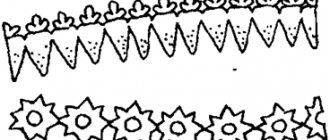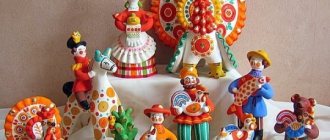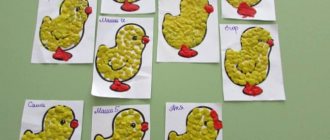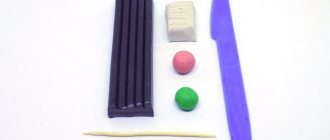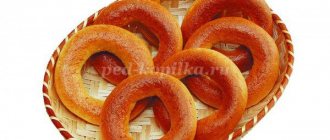Junior group. Early childhood, nursery. Children 1-4 years old
Summary of a modeling lesson “Treats for a doll” by Katya in the younger group from 3 to 4 years old Program content. Educational field "Artistic and aesthetic development"
: continue to teach how to connect the ends of a stick rolled out from plasticine, strengthen children’s ability to roll out plasticine with straight movements between their palms, develop creative imagination. Integration…
Summary of a modeling lesson in an early age group “Tanya the doll came to visit, decorate the cup”
Notes on modeling in an early age group “Tanya the doll came to visit. decorate the cup." Goal: to teach children to pinch small pieces from a piece of plasticine, roll them between their fingers, and then press them onto the workpiece. Develop fine motor skills and accuracy. Call...
Making treats for toys
You can start the lesson with something like this: the bear came to visit the hare, they gathered to drink tea, but there was nothing to drink it with. The baby will have to help the toys and make treats for them. You should not make more than 1-2 types of treats at a time, otherwise the child will get tired of the protracted activity.
- Bagel and pretzel . First we roll the sausage. To make a bagel, we connect the ends of the sausage to each other, in the case of a pretzel, we slightly cross the ends.
- Candies . Roll out a small plasticine sausage and attach small balls to the edges.
- Pie. First we roll a large bun, then flatten it. Fold the resulting flatbread in half and pinch the edges.
- Eggs on a plate . Roll a large bun, flatten it, level it with your fingers - you get a plate. Then we roll small balls and put them on a plate - these are eggs.
- Apples . We roll the balls and make small indentations in them with our fingers. Then we attach small leaf cakes to the recesses.
- Mushrooms . We roll the bun and flatten it - this is the mushroom cap, we roll the column - this is the leg. Mushrooms can be put in a basket, “collected in the forest.”
- Candies with candy wrappers . We roll small sausages or balls, and then wrap them in prepared pieces of colored paper or foil, like in a candy wrapper. Most likely, you will have to help the baby wrap the candy, because... this task is not easy. Just be careful that your baby doesn’t eat this candy, it looks too much like the real thing!
- Pie/cake/pizza . First, we make a large bun and flatten it into a not too thin flat cake - we get the base for a cake or pizza, whichever you prefer. Then we decorate with everything we have on hand: beans, pasta, peas, buckwheat or any other cereal.
Modeling from Play Doh
We got the Play Doh modeling kit (Labyrinth, My-shop) when Antoshka turned 2 years old. I should have bought it much earlier!
Modeling became my son’s favorite pastime for several months; he could sculpt 5 times a day!
We had a set called “Cookie Shop” (My-shop). It is ideal for kids.
Much later we bought the “Pizza” (My-shop), which is also for the little ones.
For children aged 1.5 - 2.5 years, it is better to buy simple Play Doh modeling kits, and older children will like all sorts of “Cake Factories”, “Mr. Nibbler”, etc.
Different sets contain different modeling accessories. These can be embossed rolling pins, cutting molds, a syringe, bas-relief shapes and much more. And, of course, the modeling mass itself.
This is one of the most useful purchases for any child.
How to sculpt with kids
Some useful tips for sculpting with kids:
- Start as early as possible. Is your baby almost a year old? - it's time to introduce him to dough or soft mass for modeling. Let him just pinch off pieces or make dents. This is very useful for the baby. In any case, much more useful than learning to “read from the cradle.”
- The younger the child, the softer the material for modeling should be. Start with salt dough or a special modeling compound such as Play Doh.
- Plasticine allows you to do things that cannot be done with dough or mass. Therefore, do not delay your acquaintance with this material. But for starters, also choose the softest one possible, for example, Beam Krokha (Labyrinth, Ozone, My-shop).
- At first, classes can last 5–15 minutes, but over time the duration of the class can be increased.
- Prepare materials and tools for sculpting in advance. Remove everything unnecessary from the table.
- Come up with a plot for each lesson, play it out. This way you can keep your child interested in modeling.
- Repeat activities that your child especially liked. But don't forget about diversity.
Store your child's crafts in a special folder, and don't forget to show off your work to guests.
Also, for variety, I recommend using ready-made manuals for classes, which I will write about at the end of the article.
I find most of the ideas for modeling in Elena Yanushko’s book “Sculpting with Young Children” (Labyrinth, Ozone, My-shop).
This manual contains a detailed description of the progress of each of the 153 lessons. This includes what you can say to your child to get him involved in a particular activity.
They are designed for children from 1 year old to at least 3 years old. They do not require complex preparation.
Crafts based on “koloboks”
- Snowman. We roll three koloboks, which we then carefully mold together. We make the eyes and mouth in a stack. The nose can be made into a stack, or you can make a carrot nose with your mother’s help.
- Tumbler . We roll two balls and mold them together. We roll two small buns separately and attach them to the sides as hands.
- Caterpillar . We roll small balls - as many as you have patience for. In my opinion, it’s best to make a caterpillar together: the baby makes a few balls, the mother makes a few, and then combine everything together. We make the face in a stack. Attach horns if desired.
- Christmas tree . I mentioned this craft earlier in the article “New Year’s Advent Calendar”. For this craft you will need a pine cone, which will be the Christmas tree. The toys on our Christmas tree will be small plasticine balls, or simply pieces of plucked plasticine. At the end of the lesson, mom fixes the Christmas tree on a plasticine base so that everyone can admire it on the eve of the holiday.
- Kolobok . The baby, of course, has rolled the bun more than once. This time, invite him to make all the small details from available materials. For example, our little bun has eyes and a nose made of peas, legs made of beans, and a hat made of buttons.
Modeling with children 1 – 3 years old
What can a child do with plasticine anyway? Below I will talk about the basic techniques and methods of sculpting with children 1 - 3 years old.
At this age there is no question of complex crafts. But you can come up with a huge number of simple activities that will certainly captivate your baby.
You can download and print the basis for all types of crafts listed in the article.
So, while modeling, we teach the baby:
Divide plasticine . You can do this in the following ways:
- pinch off small pieces and feed them to the birds;
- tear off a large piece to feed a large animal;
- Twist the sausage to separate it for the two dogs.
Flatten with your finger, press with your palm. First you make the balls, then the baby himself.
Print, color, cut out or draw the base and have your child:
- make spots on a fly agaric, giraffe, and ladybug;
- put vitamins in a jar, sweets in a plate;
- turn on the lights at the traffic lights;
- attach wheels to a car or locomotive;
- make it snow;
- stick apples to an apple tree, berries to a rowan branch, petals to a flower, seeds to a watermelon, leaves to a tree, balls to a Christmas tree, eyes to a fish or other animal
The child can sculpt elements either in any order or in specific places.
Smear with fingers or palm. Draw a small picture of an animal and ask your child:
- hide the animal, make a den for the bear, etc., by smearing plasticine over a small drawing.
Roll out modeling clay or plasticine with a rolling pin.
Play Doh modeling kits come with embossed rolling pins. Kids love to roll out the mixture and see interesting prints on it.
Make prints with various objects. You can do this with whatever comes to hand. It is advisable to use modeling clay or soft plasticine.
Press various objects into plasticine.
For such activities, we prepare the base in advance - roll out a cake about 3 mm thick in the color we need (green for grass, blue for water, etc.). We offer the baby:
- plant mushrooms or mosaic flowers;
- push pasta in the shape of cars into the plasticine road, turtles into the sand, etc. Make rays for the sun from spaghetti, worms from curled pasta, lay out shells on the sand, then collect them in a bucket, which can be fashioned in advance from plasticine;
- make a path out of beans, make beads, plant potatoes, lay out letters and numbers (closer to 3 years);
- press seeds or buckwheat into a sunflower;
- use beads, buttons, sequins to decorate a plasticine base in the form of a butterfly, fish, Christmas tree, dress;
- Use matches to make a fence for a cow and thorns for a hedgehog.
Roll into balls , large and small. This is how you can make it from plasticine:
- pies, sweets, vitamins, apples, oranges, berries, eggs, buns, snowballs.
Roll out the sausage . When rolling out the sausages, we do:
- stripes for zebra, tiger, bug;
- stairs, fence, sleepers;
- rays of the sun;
- sausage, bananas, dryers, pretzels for the doll;
- worms, snake, snail.
Draw on plasticine in a stack . Roll out the plasticine and show your child how to draw stripes, circles, and patterns on it.
Cut with a plastic knife or scissors. Separate the plasticine by applying the ruler edgewise.
- let the child make a sausage and cut it into pieces, feeding you and the animals;
- Make cookies and geometric figures from a flat piece.
Scrape off the plasticine with a stack or ruler.
- Cover small images of animals and cars with plasticine. And invite your child to find out who is hiding there.
Use a mold for bas-reliefs . Play Doh modeling kits are ideal here, but I'll talk about them below.
Coloring with plasticine.
- Print out a coloring page for little ones or draw a simple picture. Invite your child to color it by smearing the plasticine with his finger.
The main thing is that the base is small, because the child will not have enough patience for a large craft.
Connect plasticine parts together . Simple crafts from plasticine:
- fungus, carrot, apple, tumbler, snowman, rattle, candy;
- beads, grapes, caterpillar made of plasticine balls.
String plasticine onto a wire, match or thin stick:
- caterpillar, beads;
- lollipops, cherries.
Make letters and numbers . Plasticine can be stuck to printed outlines of letters and numbers, or simply sculpted without outlines.
We do all this, of course, by coming up with an interesting plot and playing it out.
Summary of a modeling lesson for the younger group on the topic “Summer carpet”
Abstract
modeling classes on the theme “Summer carpet”
in the younger group
Subject:
Modeling “Summer carpet”
Target:
learn to sculpt a rug from multi-colored plasticine by combining various geometric shapes; develop fine motor skills of fingers; cultivate a desire to sculpt from plasticine.
Preliminary work:
studying with children the primary colors of the spectrum;
Reviewing rugs and rugs. A conversation about fairy-tale carpets (which were woven by the Frog Princess, the carpet is an airplane).
Equipment:
Plasticine, napkins, squares of colored cardboard - the basis of the composition, a poster on the theme “Summer”. Modeling with children on the themes: “Sunshine”, “Lollipop”, “Mushroom”.
Progress of the lesson
- Organizing time.
A fox comes to the children’s group, cries and asks the children for help: “Hello, kids. I came to you for help. My mother fox’s birthday is coming soon, and I wanted to give her a gift - a summer rug, but I can’t do it, help me kids!”
Educator: Hello, fox! Children, can we help our guest?”
- Main part. Examination of the poster "Summer".
Guys, what time of year is it now? (summer). Let's look at this poster with you.
So summer has arrived - The strawberries have turned red: They will turn sideways to the sun - They will all be filled with scarlet juice. In the field there is a red carnation, red clover. Look: And the wild rose hips in the summer are all covered in red. Apparently, people don’t call summer red for nothing.
Educator: “Guys, what do you see on the poster? (grass, flowers, stream). That's right, guys. What is the girl doing in the poster? (picks apples). What does the bee do? (flies). Where does she fly? (near the flower). Guys, tell me what we will make a summer carpet out of, what do you think? (made of plasticine). Right! How can we decorate a summer carpet? (flowers, apples). Great. Now it’s time for us to rest a little and stretch our fingers. Foxy, are you with us?
Finger gymnastics “I draw summer”
I draw summer: (they draw with their finger on the table) With red paint - the sun, (they draw the “sun” in the air) There are roses on the lawns, (they squeeze and unclench their fingers) There are mowings in the meadows, With blue paint - the sky (they paint “clouds” in the air) And singing stream. (they draw a “stream” with their finger on the table)
- Modeling a summer rug
.
“Guys, but we have a task - how to make a rug? Maybe the fox can tell us?”
Chanterelle: “Guys, I once heard from friends how they gave their mothers the same gift. You need to take a piece of plasticine, roll it between the palms of both hands (teacher demonstration), just like Anastasia Igorevna shows you. What happened? (flagellum, rod). That's right, friends. You need to make several of these sticks and place them in a row on cardboard, but so that there is a little space between them. And put the rest of the sticks on top, only now you need to put them vertically (demonstration).”
Educator: “But does this look like a summer rug? Guys, what do you think? You can decorate it, look at our poster, there are flowers, mushrooms, and apples. We can do the same too. Is it true? Let us decorate our rugs with apples – red, green, and yellow.
(The teacher reminds the children of the sculpting technique - rolling between the palms, repeats with the children again how to sculpt a summer rug).
Guys, now it’s your turn to prepare summer rugs for our little fox. You can decorate the rug not only with apples, but also with mushrooms. But then you need to attach a stick to the mushroom.”
(During work, the teacher helps children who have difficulties in work, verbally reminds children of the sequence of work).
- Final part.
Educator: “Little fox, look at what wonderful rugs the guys have prepared for you. Masha, how did you decorate your rug? And you, Yaroslav? (the teacher analyzes the work with each child - finds out what the children decorated the rug with). Your mother will definitely like these rugs, little fox, pick them up quickly and run to congratulate your mother on her birthday. And congratulations from our children too!”
The little fox leaves: Guys, my mother definitely never had such rugs. Well done! Thank you for such a gift. Can I always come to you for help now? (children's answers) Thank you again, see you later, friends!
